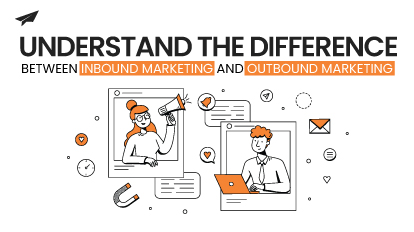Understand the difference between inbound and outbound marketing
Marketing is a vast arena, and there are hundreds of terms, strategies, practices, platforms, and a lot more that marketers use and imply every day. You must have heard terms like inbound and outbound marketing from marketers around you. But do you understand what it means? Among other jargons, these two are some of the most important ones. Since these are not just random terms but a whole concept of marketing that changes the whole perspective and strategies that are used. It defines the cultural shift in the marketing strategies specifically across each platform.
First and foremost, it is vital to understand each of these types, and only then you will be able to understand the differences.

What is outbound marketing?
Outbound marketing is basically what was known as marketing for years. The type of marketing that the audience now considers pushy and self-imposed because of the way a product is marketed forcefully to the audience regardless of what they want. Common examples include advertisements on TV and radio, newspapers and magazines, telemarketing, billboards, pop-ups, contextual ads, cold calling, banner and display ads etc. In the past decade, the audience has completely rejected outbound marketing due to oversaturation on the internet, which users find annoying. Ever since Adblocker was invented, it has gotten more manageable for the audience to block unwanted ads. Most marketers have labeled paid ads such as outdoor, print, and broadcast as overrated and not helpful.
What is inbound marketing?
Inbound marketing is the latest concept in which marketers use the ‘pull in’ technique instead of pushing the product on the audience. In this strategy, exciting and valuable content is used to engage the audience and potential customers. It is also commonly known as content marketing as well. It consists of blog posts, email newsletters, social media, white paper, infographics, and other content that people would read and enjoy. Search engine optimization, paid ads, and social media drive visibility for marketer’s content, and depending upon its caliber, the audience engages and reacts accordingly. If it is up to their liking or standards, a positive image is formed, and the brand comes in the good books, which play an essential role in future purchase decisions. Inbound marketing is a very subtle way of marketing the product. It is indirect, and you can never find a noticeable sales pitch in the content; rather, it gradually convinces and impresses the audience to turn them into a customer.
Difference between inbound and outbound marketing:
| Inbound Marketing | Outbound Marketing |
| Targets and pulls in the relevant audience | Pushes at everyone regardless of their interest |
| Constructed according to the needs of a consumer | Written only to promote a specific product |
| Engaging and fluid | Forceful and one-way |
| Customers are drawn in | It seeks out customers |
| Fits in content consumption | Interrupts content consumption |
| Platforms: blogs, social media, subscribed emails | Platforms: TV and radio ads, billboards, magazines and newspapers, display ads, etc |
These are some of the significant differences between the two types of marketing concepts. However, it does not make any of it completely useless, and the following are some of the benefits and challenges associated with both of these. It depends on the type of audience you are targeting and the product you are selling.
Benefits of both types of marketing
Let’s go through some of the benefits of inbound and outbound marketing strategies.
Inbound Marketing:
- It does not invade content consumption or interfere in it as the audience has the option to read or watch your content at their convenience.
- The content provides knowledge and is educational because it is designed according to the consumers’ needs.
- It allows quantification to connect every part of the strategy to a metric under regular observation.
- Since the content requires frequent updates, the leads also improve and increase over time.
Outbound Marketing:
- It helps brand awareness by promoting the brand to people who have not heard about it before.
- It triggers immediate results as the interested audience reacts right away and purchases if needed.
- It is an old strategy, so the audience is accustomed to it. Due to years of usage, they expect ads in a newspaper or on the TV and often trust those more than the ones which appear on modern technology.
Challenges of both types of marketing
Just like benefits, there are a few challenges to both marketing plans, which are as follows.
Inbound Marketing:
- It requires constant maintenance and updates to ensure that the content is according to a customer’s changing needs.
- Inbound marketing experts have to invest a lot of time and energy to test out different content ideas to determine the effective one.
- It requests a holistic strategy that requires tools to imply cross-channel campaigns easily on various platforms.
Outbound Marketing:
- It is impossible to make relevant and appealing content for everyone at once, and therefore, the content used in outbound marketing is primarily generic.
- It is pretty easy to cut off outbound marketing, e.g. most people mute the TV during commercials or throw out junk mail without checking.
- You cannot identify how effective a particular strategy is, such as ads on billboards.
- It is costly as renting out billboards space, printing an ad, service charges for magazine ads, etc., is not free of cost and ads up to a considerable sum.
Inbound and outbound marketing are two entirely different marketing techniques. Now it depends on your business and audience which will be the most suitable for you. We have discussed the differences between both and the challenges and benefits of each. It will help you decide better by weighing the pros and cons according to your brand requirements.






